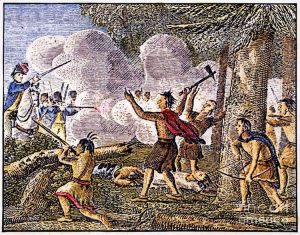Great Yamasee War of 1715
What was the Yamasee War of 1715?
The Yamasee War was a conflict that took place in the early 18th century. It was fought between a large alliance of Native American tribes and the British colonists.
The colonial forces suffered heavy losses during the war and one of the British colonies reached the verge of complete destruction. Ultimately, however, the colonists gained the upper hand and achieved a victory.
When and where was the war fought?
The Yamasee War was fought in the modern-day South Carolina state. It took place from 1715 to 1717.
Who fought in the war?
At one side were the British colonists, mainly from the South Carolina colony. At the other side was an alliance of a large number of Native American tribes. Most notable among these were the Yamasee although the alliance included a number of other tribes such as Ochese Creeks, Catawba, Cherokee, Waxhaw and Santee.

Yamasee War American American History Timeline
Background of the War
In the early 18th century, British colonies of North Carolina and South Carolina existed along the eastern coast of North America. In 1711, North Carolina faced attacks from the neighboring Indian tribes. South Carolina colony sent support to North Carolina in order to fight off the Indian attacks.
This support included warriors from many allied tribes, including the Yamasee. Yamasee and other tribes saw the organization, strengths and weaknesses of the British colonies and militias during this period. They would later use this knowledge to their advantage in the Yamasee War.
Events Leading to the War
Yamasee were trading partners with the British colonies, most notably South Carolina. They would supply the colonists with furs, trading them for items like firearms. However, excessive hunting greatly reduced the supply of deer and other game animals in the region.
This ultimately caused the Yamasee to become indebted to the colonists, as they bought things on credit. The colonists, on the other hand, sought to take over the Yamasee lands against their debts.
These factors contributed to the outbreak of the war. When a delegation from South Carolina visited Yamasee in 1715, most of the delegation members were killed. This marked the beginning of the war.
The Fighting
Although the Yamasee initiated the war, it was soon joined by a large number of other Indian tribes. The tribes attacked white settlements all along the South Carolina colony and neighboring areas. Hundreds of colonists were killed during these attacks.
Other colonists left their farms and lands, fleeing to the safety of Charles Town which was better fortified against attacks. But the large number of refugees soon led to starvation as the colonists couldn’t go out for supplies.
In 1716, things improved for the colonists when the Native American Cherokee tribe decided to support them. Cherokee helped in bringing food supplies to the colony and offered much needed help. This finally began to turn the tide in favor of the colonists.
Result and Aftermath
By 1717, most of the Native American tribes who fought the colonists had stopped fighting or signed peace treaties. Some like Yamasee continued their raids over the next years but the war was over in 1717 for the most part.
The colonists suffered hundreds of deaths during the war. Yamasee also lost a large portion of their population which was either killed or enslaved. Following the war, Yamasee became scattered and ceased to exist as a large tribe.
Yamasee War Fast Facts
- The Yamasee War of 1715 was a conflict between Yamasee Indians and other tribes against the colonists.
- Yamasee War cause – colonists sought to gain the Yamasee lands against debts owed by them by the Yamasee and other tribes through trading.
- The Yamasee War of 1715 was fought in modern day South Carolina state from 1715 to 1717.
- The Colonist gained the upper-hand and were ultimately victorious.
- The Yamasee War of 1715 ended when a peace treaty was signed in 1717
Learn More about the Yamasee War at Wikipedia